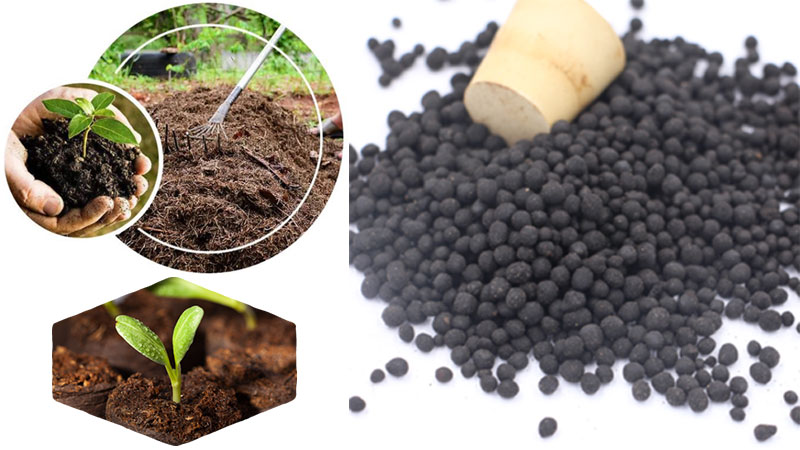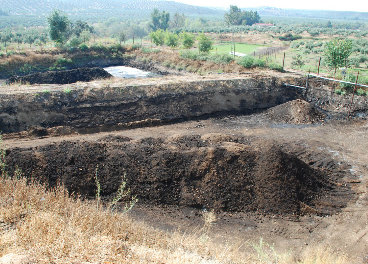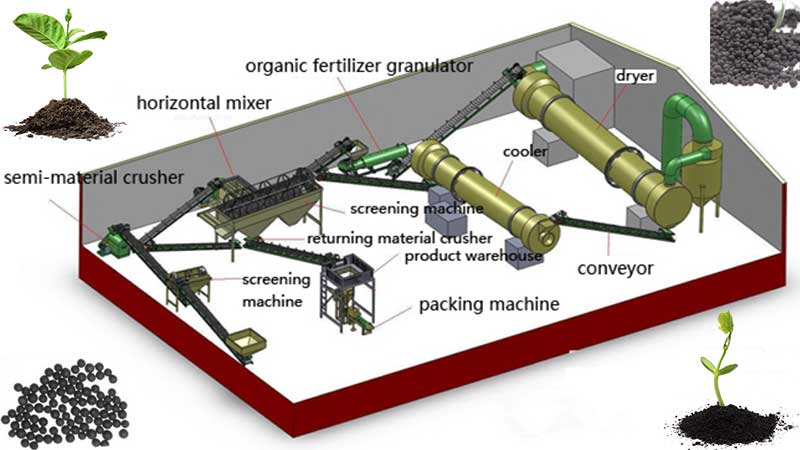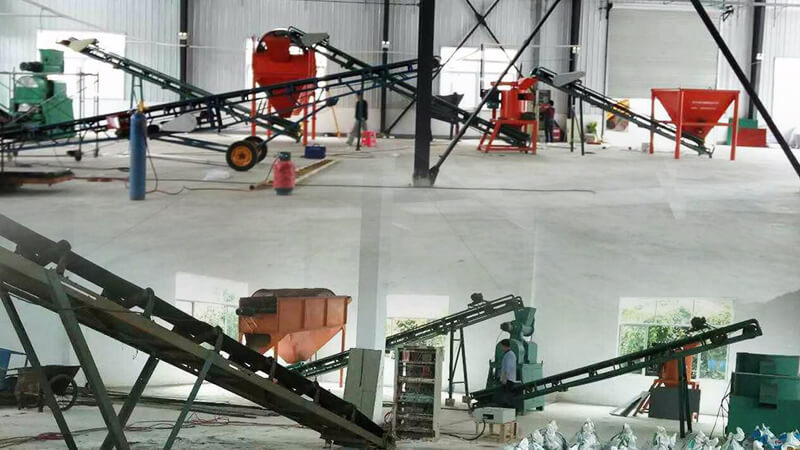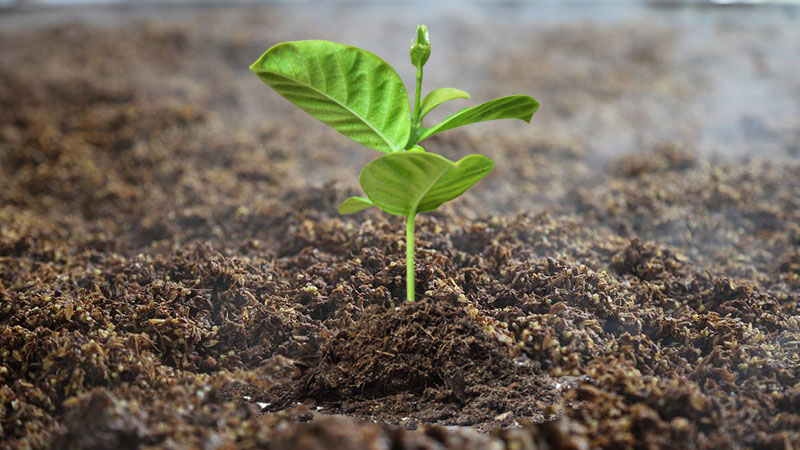With the rapid development of animal husbandry, livestock breeding has been more localized and intensive. With the enlarging of animals raising scales, the amount of livestock manure is increasing. The application of livestock manure directly influences environmental security and sustainable development of animal husbandry. It is the most direct and effective measure to apply livestock manure in agriculture, so commercial organic fertilizers , which are made of organic waste, can not only realize recycle of nutrients, and increase soil fertility, but decrease chemical fertilizer use, and promote agricultural sustainable development.
In organic fertilizer manufacturing process, manure compost and fermentation of organic wastes are the core technology, which aims to create a better environment condition for normal microbial breeding, to promote microbial metabolic process, to accelerate decomposition and transformation of organic wastes, to kill pathogens and parasite eggs, and finally granulate quality commercial granular organic fertilizers. In organic wastes fermentation, there are 5 factors affecting the final quality of the organic compost, which will directly influence the final quality of the granulated organic fertilizer. They are Water, Temperature, C/N ration, Ventilation and oxygen supplying, and pH, which are environmental factors. While in the whole fermentation process, by artificially control of fermentation and organic compost conditions, creating suitable environment for aerobic activity, and promote rapid fermentation of raw materials, standardized commercial organic fertilizers will be manufactured.
Quality Control for Organic Fertilizers
Condition control of organic fertilizer production, in practice, is interaction of physical and biological properties in the process of compost heap. On the one hand, the control condition is interactional and interinhibitive. On the other hand, different windrows are mixed together. Because of diverse in nature and different degradation velocity, it is hard to control organic fertilizers. Many studies and tests indicate that the main environmental factors are water, temperature, C/N, ventilation and oxygen supplying and pH. It creates an suitable environment for microbial activities through controlling 
1.Water control
Moisture is an important requirement for organic composting. In the process of manure composting, relative water content of the original material of composting is 40% to 70%, to ensure the smooth progress of compost. The most suitable moisture content is 60-70%. Too high or too low material moisture content can impact aerobic microbial activity so that water regulation should be carried out before fermentation. When material moisture content is less than 60%, heating up is slow, temperature is low and decomposition degree is inferior. The moisture is more than 70%, having an effect on ventilation, which forms into anaerobic fermentation, slow heating and poor decomposition.
Studies have shown that adding water into compost heap can accelerate compost maturity and stability in the most active phrase. Water volume should remain 50-60%. Moisture should be added thereafter maintained at 40% to 50%, while it should not be leaking. Moisture should be controlled below 30% in the products. If the water content is high, it should be drying at the temperature of 80℃.
2.Temperature control
Temperature is the results of microorganisms activity. It determines the interaction of materials. At the temperature of 30 ~ 50℃ in the initial stage of compost heap, mesophile activity can generate heat, prompting the temperature of compost. The optimum temperature was 55 ~ 60℃. Thermophilic microorganisms can degrade a large number of organic materials and quickly break down cellulose in a short time. High temperature is the necessary condition for killing the poisonous wastes, including pathogens, parasite eggs and weed seeds, etc. Under normal circumstances, it takes 2 ~ 3 weeks to kill hazardous waste at the temperature of 55 ℃ , 65 ℃ for 1 week, or 70 ℃ for several hours.

Composting is another factor for temperature control. Composting can control the temperature of materials and enhance evaporation, forcing air through the heap. It is an effective method for reducing the reactor temperature to use self-propelled compost turner. It is characterized by easy operation, low price and high performance. To adjust the frequency of composting controls the temperature and the timing of maximum temperature.
3.C/N ratio control
When C/N ratio is appropriate, composting can be produced smoothly. If C/N ratio is too high, due to lack of nitrogen and limited growing environment, degradation rate of organic wastes becomes slow, causing to longer manure composting time. If the C/N ratio is too low, the carbon can be utilized fully utilized, an excess of nitrogen loses in forms of ammonia. It not only affects the environment but also reduces the efficiency of nitrogen fertilizer. Microbes compose microbial protoplasm during organic composting. On a dry weight basis, protoplasm contains 50% carbon, 5% nitrogen and 0. 25% phosphate. Therefore, researchers recommend that suitable C/N of compost is 20-30%.
C/N ratio of organic compost can be adjusted by adding materials that contain high carbon or high nitrogen. Some materials, such as straw, weeds, deadwood and leaves, contain fibers, lignin and pectin. Because high C/N, it can be used as high-carbon additive material. On account of high nitrogen content, livestock manure can be used as high-nitrogen additives. For instance, pig manure contains ammonium nitrogen that is available for 80 percent of the microbes, so as to effectively promote microbial growth and reproduction and accelerate compost maturity. New type organic fertilizer granulator is suitable for this phase. When origin materials enter the machine, additives can be added according to different requirements.
4.Ventilation and oxygen supplying
It is an significant factor for manure composting to have enough air and oxygen. Its main function is to provide necessary oxygen for microbial growth. To regulate reaction temperature by controlling ventilation so as to control the maximum temperature of composting and time of occurrence. While maintaining the optimum temperature conditions, to increase ventilation can remove moisture. Proper ventilation and oxygen can reduce nitrogen loss, malodor production and moisture of compost product, which is easy to store products.
The moisture of organic fertilizers has an effect on aeration porosity and microbial activity, affecting the oxygen consumption. It is a decisive factor in aerobic composting. It needs to control moisture and ventilation on the basis of the properties of materials, to achieve coordination of water and oxygen. While in consideration of both, it can promote microbial growth and reproduction and optimize control condition.
The study has shown that oxygen consumption increases exponentially below 60 ℃, lower consumption higher than 60 ℃ and close to zero above 70 ℃. The amount of ventilation and oxygen should be controlled in accordance with different temperature.
5. pH control
The pH value impacts the entire composting process. In the initial stage of composting, pH affects bacterial activity. For example, pH=6.0 is the boundary point for pig mature and saw-dust. It inhibits carbon dioxide and heat generation at pH <6.0. It increases rapidly in carbon dioxide and heat generation at PH> 6. 0. While entering high temperature phase, the combined action of high pH and high temperature leads to volatilization of ammonia. Microbes degrade into organic acid with composting, resulting in pH reduction, to 5 or so. And then volatile organic acids volatilize because of rising temperature. In the meanwhile, ammonia, denigrated by organics, makes pH rise. Eventually, it stabilizes at a high level. In the high temperature of compost, pH value at 7.5 ~ 8.5 can achieve maximal composting rate. Too high pH can also cause excessive volatilization of ammonia, thus it can reduce the pH by the addition of alum and phosphoric acid.
In short, to control the quality of organic fertilizers is not simple. It is relatively easy for a single condition. However, the materials are interacted and interinhibitive. To achieve the whole optimization of composting condition, every process should be cooperated. When the control condition is proper, composting can be processed smoothly. Therefore, organic fertilizers of high quality can be produced and best fertilizer can be used for plants.
